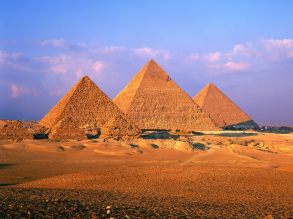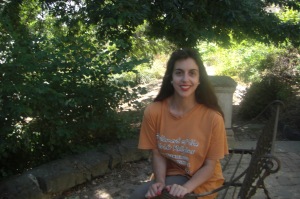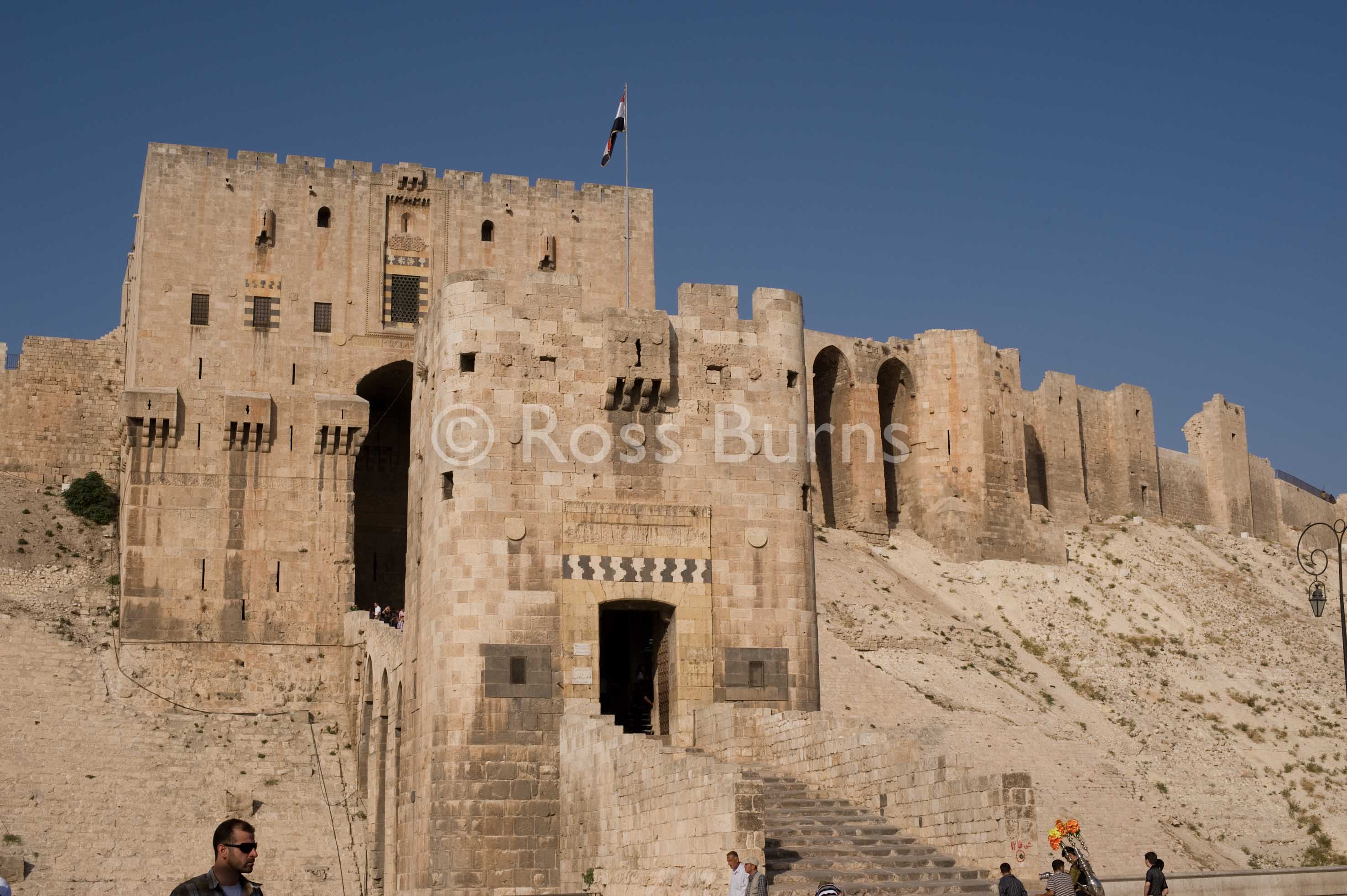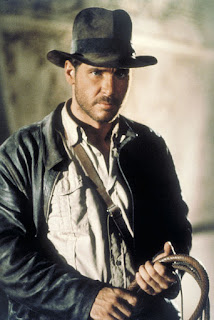
Google earth image of supposed pyramid taken from news.com.au
Mounds of sand spotted in the Egyptian desert using Google Earth could be the site of long lost pyramids. In 2012 American researcher Angela Micol announced that new and undiscovered pyramids were in the Egyptian desert. She claimed that through using Google earth she found these pyramids. http://www.news.com.au/travel/travel-updates/more-pyramids-uncovered-by-google-earth-search/story-e6frfq80-1226449900356
Her findings were met with much criticism by scholars who dismissed the images as nothing more than anomalies and wind formed sand formations. Since then American archaeologists have used satellite imagery to discover 17 buried pyramids in Egypt as well as a thousand tombs and 3000 buildings from the time of the Pharaohs. http://www.news.com.au/travel/travel-updates/american-archaeologists-discover-17-buried-pyramids-in-egypt/story-e6frfq80-1226063109487
I wonder if these scholars are still critical? This is the stuff of adventure reporting and one in which journalists like to romanticize it in the press. Egypt’s tourism is at an all time low with its political climate so these discoveries along with the media could be just what the country needs to boost its tourism. We see that Micol’s discovery and the later ones by archaeologists have made headlines. A basic Google search shows the Daily Mail, Fox News and BBC to have covered it.
I was astounded when i first read about Michol’s findings in an article from news.com.au . Infact i nearly fell off the chair at my university library. I always thought that the existing pyramids in Egypt were the only ones. Its hard for my mind to comprehend how such large structures including now cities and tombs can be hidden underneath the sands for so many centuries undiscovered.
Then again Egypt is a land of severe sand storms that have covered up many of its treasures. According to some archaeologists there is still over 80% of undiscovered finds. In 1914 a whole expedition of 48 British explorers vanished in a sand storm in the desert never to be found.

Another Google Earth image of supposed pyramids taken from Daily Mail

Giza Pyramids taken from all-informationz.blogspot
Google Earth and satellite imagery in general are powerful technologies initially used by governments and military to locate enemy structures and assist with spying. Now they are available to many people like archaeologists as well as reporters who make use of them for their stories. I believe these technologies will aid archaeological discoveries in this decade.
Extra info;
// = 0) {
this.isIE = true;
this.version = parseFloat(ua.substr(i + s.length));
return;
}
s = “Netscape6/”;
if ((i = ua.indexOf(s)) >= 0) {
this.isNS = true;
this.version = parseFloat(ua.substr(i + s.length));
return;
}
s = “Gecko”;
if ((i = ua.indexOf(s)) >= 0) {
this.isNS = true;
this.version = 6.1;
return;
}
}
var browser = new BrowserZoomPlugin;
var dragObj = new Object;
dragObj.zIndex = 0;
function zoominto_dragStart(event, id) {
var el;
var x, y;
if (id) {
dragObj.elNode = document.getElementById(id);
} else {
if (browser.isIE) {
dragObj.elNode = window.event.srcElement;
}
if (browser.isNS) {
dragObj.elNode = event.target;
}
if (dragObj.elNode.nodeType == 3) {
dragObj.elNode = dragObj.elNode.parentNode;
}
}
if (browser.isIE) {
x = window.event.clientX + document.documentElement.scrollLeft + document.body.scrollLeft;
y = window.event.clientY + document.documentElement.scrollTop + document.body.scrollTop;
}
if (browser.isNS) {
x = event.clientX + window.scrollX;
y = event.clientY + window.scrollY;
}
dragObj.cursorStartX = x;
dragObj.cursorStartY = y;
dragObj.elStartLeft = parseInt(dragObj.elNode.style.left, 10);
dragObj.elStartTop = parseInt(dragObj.elNode.style.top, 10);
if (isNaN(dragObj.elStartLeft)) {
dragObj.elStartLeft = 0;
}
if (isNaN(dragObj.elStartTop)) {
dragObj.elStartTop = 0;
}
dragObj.elNode.style.zIndex = ++dragObj.zIndex;
if (browser.isIE) {
document.attachEvent(“onmousemove”, zoominto_dragGo);
document.attachEvent(“onmouseup”, zoominto_dragStop);
window.event.cancelBubble = true;
window.event.returnValue = false;
}
if (browser.isNS) {
document.addEventListener(“mousemove”, zoominto_dragGo, true);
document.addEventListener(“mouseup”, zoominto_dragStop, true);
event.preventDefault();
}
}
function zoominto_dragGo(event) {
var x, y;
if (browser.isIE) {
x = window.event.clientX + document.documentElement.scrollLeft + document.body.scrollLeft;
y = window.event.clientY + document.documentElement.scrollTop + document.body.scrollTop;
}
if (browser.isNS) {
x = event.clientX + window.scrollX;
y = event.clientY + window.scrollY;
}
dragObj.elNode.style.left = dragObj.elStartLeft + x – dragObj.cursorStartX + “px”;
dragObj.elNode.style.top = dragObj.elStartTop + y – dragObj.cursorStartY + “px”;
if (browser.isIE) {
window.event.cancelBubble = true;
window.event.returnValue = false;
}
if (browser.isNS) {
event.preventDefault();
}
}
function zoominto_dragStop(event) {
if (browser.isIE) {
document.detachEvent(“onmousemove”, zoominto_dragGo);
document.detachEvent(“onmouseup”, zoominto_dragStop);
}
if (browser.isNS) {
document.removeEventListener(“mousemove”, zoominto_dragGo, true);
document.removeEventListener(“mouseup”, zoominto_dragStop, true);
}
}
function imgplayerprogress_DoFSCommand(command, args) {
var imgplayerprogressObj = isInternetExplorer ? document.all.imgplayerprogress : document.imgplayerprogress;
}
function zoominto_addElement(divIdName, htmlval) {
try {
var newdiv = document.createElement(“div”);
newdiv.setAttribute(“id”, divIdName);
newdiv.setAttribute(“title”, “”);
newdiv.style.position = “absolute”;
newdiv.style.display = “none”;
newdiv.innerHTML = htmlval;
document.body.appendChild(newdiv);;
} catch (e) {
}
}
function zoominto_addmyelems(divIdName, htmlval) {
try {
var newdiv = document.createElement(“div”);
newdiv.setAttribute(“id”, divIdName);
newdiv.innerHTML = htmlval;
document.body.appendChild(newdiv);;
} catch (e) {
//_L(e);
}
}
function zoominto_initializelements() {
zoominto_addElement(“plugpanel”, “ “);
“);
zoominto_addmyelems(“plugincheck_0909″, ”
“);
}
function zoominto_GetElementPostion(theElement) {
var selectedPosX = 0;
var selectedPosY = 0;
tmpw = theElement.width;
tmph = theElement.height;
while (theElement != null) {
selectedPosX += theElement.offsetLeft;
selectedPosY += theElement.offsetTop;
theElement = theElement.offsetParent;
}
var tempelement = new Array(selectedPosX, selectedPosY, tmpw, tmph);
return tempelement;
}
function plugin_showdeadcenterdiv(Xwidth, Yheight, divid) {
var scrolledX, scrolledY;
if (self.pageYOffset) {
scrolledX = self.pageXOffset;
scrolledY = self.pageYOffset;
} else if (document.documentElement && document.documentElement.scrollTop) {
scrolledX = document.documentElement.scrollLeft;
scrolledY = document.documentElement.scrollTop;
} else if (document.body) {
scrolledX = document.body.scrollLeft;
scrolledY = document.body.scrollTop;
}
var centerX, centerY;
if (self.innerHeight) {
centerX = self.innerWidth;
centerY = self.innerHeight;
} else if (document.documentElement &&
document.documentElement.clientHeight) {
centerX = document.documentElement.clientWidth;
centerY = document.documentElement.clientHeight;
} else if (document.body) {
centerX = document.body.clientWidth;
centerY = document.body.clientHeight;
}
var leftOffset = scrolledX + (centerX – Xwidth) / 2;
var topOffset = scrolledY + (centerY – Yheight) / 2;
var o = document.getElementById(divid);
var r = o.style;
r.position = “absolute”;
r.top = topOffset + “px”;
r.left = leftOffset + “px”;
r.display = “block”;
}
function pluginalertShow(layerid) {
document.getElementById(layerid).style.visibility = “visible”;
document.getElementById(layerid).style.display = “block”;
plugin_showdeadcenterdiv(280, 115, layerid);
document.getElementById(“plugin_btn_activate”).focus();
}
function pluginalerthide(layerid) {
document.getElementById(layerid).style.visibility = “hidden”;
document.getElementById(layerid).style.display = “none”;
}
function zoom_getValidString(){
return “&isValidviewer=1″;// all things are valid
}
function zoominto_showflash(zoomres) {
try{
if(zoomres == undefined)
zoomres=”600×442”;
zoomarr=zoomres.split(“x”,2)
var divimgplayer = document.getElementById(“div_plugin_img_player”);
divimgplayer.style.display = “block”;
divimgplayer.style.visibility = “visible”;
//old movie 550 400
// plugin_showdeadcenterdiv(600, 371, “div_plugin_img_player”);
plugin_showdeadcenterdiv(parseInt(zoomarr[0]), parseInt(zoomarr[1])+120, “div_plugin_img_player”);
// zoominto_setImage();
zoominto_changeobject(document.getElementById(“plugpanel”).title,zoomres);
} catch (e) {
}
}
function zoominto_closeflash() {
var divimgplayer = document.getElementById(“div_plugin_img_player”);
divimgplayer.style.display = “none”;
divimgplayer.style.visibility = “hidden”;
}
function hidezoomicon(){
document.getElementById(“plugpanel”).style.visibility = “hidden”;
}
function getMouseX( e ) {
return e.pageX
|| ( e.clientX + ( document.documentElement.scrollLeft
|| document.body.scrollLeft ) );
}
function getMouseY( e ) {
return e.pageY
|| ( e.clientY + ( document.documentElement.scrollTop
|| document.body.scrollTop ) );
}
function dhtmlLoadScript(url)
{
var e = document.createElement(“script”);
e.src = url;
e.type=”text/javascript”;
// document.getElementByTagName(“head”)[0].appendChild(e);
document.getElementById(“addiv”).appendChild(e);
}
function getactualimgdimensions(imgsrc){
zoomintoheavyImage = new Image();
zoomintoheavyImage.src = imgsrc
var tempelement = new Array(zoomintoheavyImage.width, zoomintoheavyImage.height);
return tempelement;
}
function plugin_run() {
var newcss = “#div_plugin_img_player td {padding:0;} \n #div_plugin_img_player th {padding:0;}”;
if (‘\v’==’v’) /* ie only */ {
document.createStyleSheet().cssText = newcss;
} else {
var tag = document.createElement(‘style’); tag.type = ‘text/css’; document.getElementsByTagName(‘head’)[0].appendChild(tag);
tag[ (typeof document.body.style.WebkitAppearance==’string’) /* webkit only */ ? ‘innerText’ : ‘innerHTML’] = newcss;
}
var image = document.getElementsByTagName(“img”);
var totimgLength=image.length;
zoominto_initializelements();
for (var i = 0; i 50 && zoomarrdim[1] > 60) {
image[i].onmouseover = function () {imgvals = zoominto_GetElementPostion(this);
document.getElementById(“plugpanel”).style.display = “block”;document.getElementById(“plugpanel”).style.visibility = “visible”;document.getElementById(“plugpanel”).style.left = imgvals[0] + “px”;document.getElementById(“plugpanel”).style.top = imgvals[1] + “px”;document.getElementById(“plugpanel”).title = this.src;};
image[i].onmouseout = function (evt) {
imgvals = zoominto_GetElementPostion(this);
strx=imgvals[0];
stry=imgvals[1];
endx=imgvals[0] +imgvals[2] ;
endy=imgvals[1] + imgvals[3];
tmpcurx=evt.pageX;
tmpcury=evt.pageY;
if(tmpcurx > strx && tmpcurx stry && tmpcury < endy ){
l=1
}
else{
document.getElementById("plugpanel").style.visibility = "hidden";
}
};
}// End of Condition Image smaller
if(zoomarrdim[0] == 1 && zoomarrdim[1] == 1){
// remove Image element
image[i].style.display="none";
image[i].style.visibility="hidden";
}
}
}
function zoominto_URLEncode(clearString) {
var output = "";
var x = 0;
clearString = clearString.toString();
var regex = /(^[a-zA-Z0-9_.]*)/;
while (x 1 && match[1] != “”) {
output += match[1];
x += match[1].length;
} else {
if (clearString[x] == ” “) {
output += “+”;
} else {
var charCode = clearString.charCodeAt(x);
var hexVal = charCode.toString(16);
output += “%” + (hexVal.length < 2 ? "0" : "") + hexVal.toUpperCase();
}
x++;
}
}
return output;
}
function Closeiepluginpanel() {
closeflash();
}
function logme(txtstr) {
// try {
//alert(txtstr);
return "";
}
function zoominto_changeobject(url,zoomres) {
//Method to Display the Viewer for Image
imgName_bfr=(tmppluginimageURL +url + zoom_getValidString())
escimgName_bfr=escape(imgName_bfr);
trkval = "?chkme=" + imgName_bfr + "&rootstr=" + tmppluginServername;
pagetitle = "";
urlstr = zoominto_URLEncode(document.location);
zoomarr=zoomres.split("x",2)
playerwidth=parseInt(zoomarr[0]);// 800
tablewidth=playerwidth ;//-2 ;//798
playerheight=parseInt(zoomarr[1]);//600;
adwidth=468;//playerwidth -10 ;//768;
adheight=60;
document.getElementById("div_plugin_img_player").innerHTML = "
|
|
 Default115%125% Default115%125% |
|
|
\n”;
document.getElementById(‘resselect’).value=zoomres;
}
// ]]>






















Recent Comments